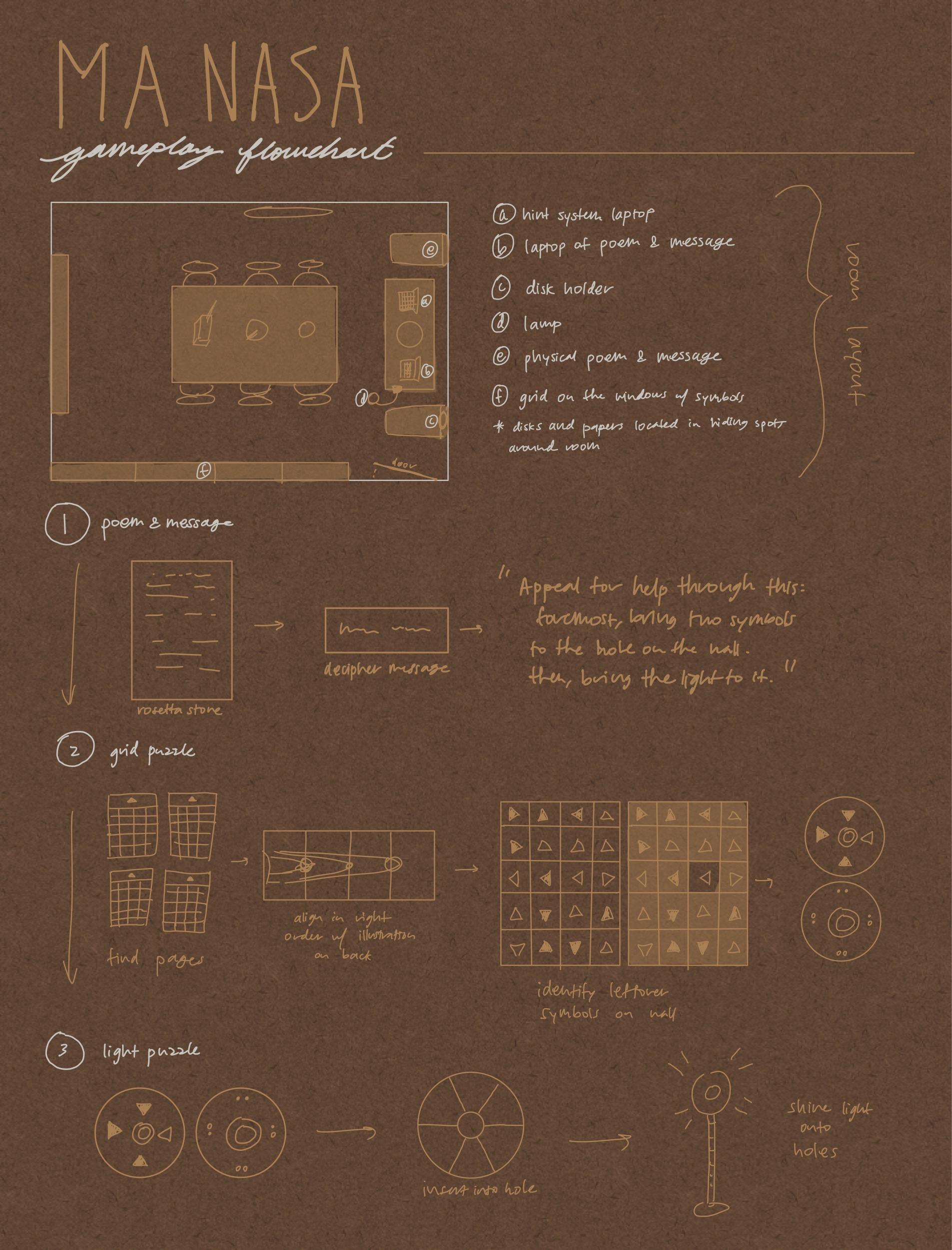Artist’s Statement
Ma Nasa (Weird Place) is an escape room built around authenticity and immersion. While we quickly made the decision to hone in on the theme of outer space, formulating how to best develop that theme — from puzzles to spatial design to soundtrack — proved a nuanced, iterative process. At each stage of development, we considered not only how potential options stacked up against each other, but also how they weaved in with the greater design of the escape room.
With that in mind, the aim is for Ma Nasa to be — more than just a game — an experience for the players. Of course, having fun, bonding as a team, and feeling enriched through (hopefully) conquering challenges are peripheral benefits. What these all rely upon, however, is a compelling, believable experience as a whole. Along the way, each moment should feel all the more tense, and all the more revelatory, for the surrounding context. Where we have achieved our goals most effectively, returning to reality from Ma Nasa should be similar to, perhaps aptly, coming back from outer space — the travelers aware of the journey they just took, yet incapable of identifying all the minutiae that made for a different world.
Map of Chosen System
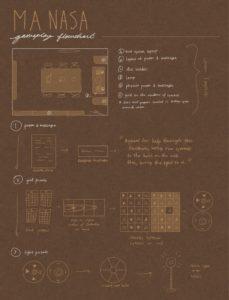
Initial Decisions on Formal Elements & Values
Although there are different formats, escape rooms normally operate as players vs. game; that is, some number of players team up to “beat” the room. After discussing different types of systems (for example, giving each player a unique goal, or having one person attempting to sabotage the entire endeavor), we settled on the classic approach. The number of players teamed up can vary based on their overall puzzle acumen and escape room familiarity, but given our interest in creating puzzles of a moderate difficulty, something in the range of 4-6 players felt most appropriate.
Three types of fun, in particular, were what we centered Ma Nasa around: fellowship, discovery, and challenge. Fellowship fun was a given consideration once we made the decision to have players vs. game as the main format; creating time pressure, ambiguous puzzles, and a sense of tension fostered that angle. As for discovery fun, the choice of setting should heighten the effect; space is inherently uncharted territory, and even more, the players are put to task exploring an alien civilization. Our use of props contributes to establishing this curiosity, and one could imagine coming up with a full backstory to the civilization — even if we eschew sharing much extraneous information to avoid distracting players. When it comes to challenge fun, we designed puzzles that were both tricky and unique. Ultimately, using our own personal expertise — combined with the underlying priority of what made sense authentically in our room—made for the design of fulfilling puzzles in their relevance, as well as the general framework.
As far as demographics, our target audience likely lands somewhere in the 16-25 age range, with prior game experience not needed but certainly helpful. That meant two things: 1) Even if we had our eye on challenge fun, the difficulty of the puzzles needed to have some flexibility. 2) Our introductory process needed to offer smooth onboarding.
Since unlike many digital games, where sliders and toggles can easily tweak difficulty, we needed an alternative, we formulated a robust hint system. By thinking from the players’ perspective and observing playtests, we crafted and revised numerous hints for the puzzles. For the most savvy players, these hints may never be needed or seen; for those who get stumped, they may very nearly lead to the solution. Heeding the advice of Laura Hall, our aim was for players to succeed; putting the hints on a timer allows the pace that one completes the room at to be an indicator for their relative success (just in case competitive fun, or feeding an ego, is someone’s goal), and using this structure bridged the desire to make things stimulating and balanced for all players. As for our onboarding, we sought simplicity — a technically-designed web app quickly lays out the context for the room. In addition, this web app delivers the hints, streamlining any complication of additional touchpoints for the players through a central portal that also includes the countdown timer.
Initially, we flirted with the idea of having our escape room be fully accessible for blind or visually-impaired players — given the location of outer space, it was going to be in the dark. As we fleshed out our ideas for the puzzles and saw the physical location, however, that became impractical. Instead, light itself became a tool; to complete our game, one needs to make use of it, setting off a light sensor we created ourselves. We designed our poem, poster, and discs, then printed them in the Product Realization Lab in order to have a consistent and deliberate visual feel. Props from the Theater and Performance Studies department accompany the remainder of the physical space, too, and the web app takes a galactic representation. In the auditory realm, we combed through swaths of music to make a background playlist (sporting no lyrics, of course, lest one get too curious about the alien analysis of human language) that helped convey our greater sense of tension and mystery. Once again, the sound effects of the web app, such as the notification when a new hint is available, are carefully chosen to maintain immersion.
Testing & Iteration History
Initial Design
Originally, we envisioned our escape room to achieve a number of goals. Specifically, it was intended to incorporate: 1) The aesthetics of fellowship, discovery, and challenge. 2) Mental and physical puzzles that are cohesive with the narrative. 3) The intentional use of space. 4) At least one technical component. 5) A completion time of 30-45 minutes.
In further iterations, we added the sixth goal of incorporating: 6) A robust hint system.
Our initial design was largely informed by the first five goals. Thematically, we created a narrative where the players were stranded astronauts trying to signal for help from within an alien structure. Players succeed by activating the signal before depleting their oxygen supply (time limit). Aesthetically, this creates an urgency to escape (challenge), encourages cooperation (fellowship), and allows us to construct a variety of cryptographic “alien” puzzles (discovery).
Structurally, we wanted our playable slice to have two main tasks — one mental and one physical — with a seamless transition from the first to the second. The first (mental) task would involve decrypting an alien “Rosetta Stone” poem (featuring English and a constructed language) in order to deduce the meaning of a sign (written in a constructed language), which serves as instructions for the second task. The second (physical and spatial) task would involve aligning mirrors to reflect a light beam to a sensor (which would be the technical component).
Initial Adjustments
Even before playtesting, our team encountered challenges. For the second (physical and spatial) task, it was hard for us to obtain a concentrated light source that can be picked up by a sensor after being reflected across multiple surfaces. Thus, we opted not to include mirrors so the players could shine a light directly onto the sensor instead. To achieve a spatial experience, however, we added another simple puzzle after scouting out Durand 410, where our final playtest would take place. For the new puzzle, we took advantage of the 4×5 window panes in the room. Players had to use symbols drawn onto the window panes and a series of hints to deduce the correct discs, which would be inserted into the light sensor to activate it.
Playtesting & Iterations
Our escape room then went through several rounds of playtesting and iterations. All groups consisted of Stanford students in CS 247G. First, the two puzzles were playtested separately. The first puzzle (featuring the poem and sign) was playtested 3 times by groups of 2-4 people. The second puzzle (featuring the discs and window panes) was playtested 2 times by 1 person. Lastly, we hosted a final playtest of the entire playable slice in Durand 410.
Puzzle 1 Playtesting
Iteration 1
Our alien “Rosetta Stone” poem featured English alongside a constructed language called Toki Pona. Lines of English translations were interposed between the Toki Pona lines. For our first iteration, our goal was simply to gauge the difficulty of the translational task. The puzzle was attempted by 4 players.
Observations
- Players quickly began matching symbols to phrases.
- Players were very vocal in communicating their thoughts to each other. They scribbled on scratch paper extensively.
- Players began to piece together more complex sentiments about 7 minutes in.
- Two players were the most active, while the others looked on passively.
- Players solved the puzzle in 18 minutes.
Feedback
- Players found it hard for everyone in the group to look at the poem at once.
- Players found compound words difficult to translate.
- Players expressed difficulty in establishing relationships between English and Toki Pona phrases.
Adjustments
- Provide scratch paper, or some other means of notetaking.
- We made the poem prop larger. The final prop would be laser printed on a 24×18 inch duron board.
- In Toki Pona, simple words are combined to form compound words (e.g. air + move = wind), which are often required even to convey relatively simple concepts. Also, grammar differences mean that the words of the two languages do not match one-to-one in a sentence. For these reasons, we adjusted several portions of the English translation to contain more straightforward, elementary wording.
- We began to consider implementing a hint system.
Iteration 2
For the next iteration, we wanted to test whether our adjustments had sufficiently lowered the difficulty of the puzzle to a reasonable level, or if more extensive measures (e.g. creating a hint system) were necessary. The puzzle was attempted by 3 players.
Observations
- Players exhaustively tried to match words, assuming a one-to-one correspondence.
- Players were far less vocal, and took far less notes than the previous group.
- Players were obviously frustrated and got stuck often, requesting several hints from the moderators. They gave up after 19 minutes.
Feedback
- Players found the puzzle far too difficult. Specifically, they found the poem too long and the language structure too complicated, both of which they felt made the task less enjoyable.
- Players found the puzzle confusing, in part because they did not know if they were making progress or not.
Adjustments
There was a marked difference between the experiences and behaviors of the first and second groups of players. The former realized the lack of one-to-one correspondence fairly quickly without prompting, whereas the latter did not. The first group also vocalized and shared their thought processes with each other much more than the second group.
To ensure a more consistent experience where everyone can track their progress and succeed, we decided to format the puzzle as a fill-in-the-blank challenge. We also envisioned a system where players would be notified whether they filled in certain blanks correctly or incorrectly.
Iteration 3
For the third iteration, we wanted to test the manageability and effectiveness of our puzzle as a fill-in-the-blank challenge. We decided to tell the players whether blanks were filled in correctly or not. This puzzle was attempted by 2 players.
Observations
- Players quickly knocked out several obvious blanks. They decrypted the first line within 6 minutes.
- Instead of reading through large portions of the poem, the players attempted the challenge by directly searching for certain symbols.
- Near the end, players largely shotgunned guesses and looked for confirmations from the moderators.
- The puzzle was solved in 11 minutes (a much improved time).
Feedback
- Players found the passage to be a bit long. However, this did not appear to be much of a problem because they completed the puzzle in a very reasonable time, and did not have to read through the whole poem to do so.
Adjustments
The reassurance from this very successful iteration informed our decision to create a web application accordingly. The web application will serve the purposes of: 1) Describing the narrative scenario. 2) Tracking the amount of time left. 3) Providing 4 hints per puzzle (8 total) that are unlocked sequentially over time and increase in the level of assistance. 4) Providing an English template for the translation where players fill in the blanks, and telling the players whether blanks are correctly or incorrectly filled in.
Since the hints unlock over time (the duration of which is not shown), players would be motivated to attempt the puzzle on their own first. Also, the increasing obviousness of the hints meant that players of all levels of linguistic mastery would be able to enjoy the challenge. Thus, we believed that the web application would make the puzzle more manageable and enjoyable for everyone.
Puzzle 2 Playtesting
Iteration 1
In preparation, we drew out the 6 4×5 grids of symbols on a whiteboard. Hints were provided in the form of 6 sheets of paper, which featured corresponding 4×5 grids with black and white squares. The ordering of the sheets was encoded in the number of times the sheets were folded. To solve the puzzle, players had to note down the symbols corresponding to the white squares, which points you to the 2 correct discs.
For our first iteration, we simply wanted to gauge the difficulty and feasibility of our puzzle. Because of its simplicity, this puzzle was attempted by 1 player.
Observations & Feedback
- The player found the folds difficult to observe, as the fold lines were obscured by the grids printed on the pages.
Adjustments
- Instead of folding the pages, we encoded the order of the pages by drawing an interconnected picture on the backsides of the page. Players can piece the pages together by referencing the picture.
Iteration 2
For the second iteration, we wanted to see if our adjustments made solving the puzzle more smooth and manageable. This puzzle was attempted by 1 player.
Observations & Feedback
- The player found the puzzle straightforward. This was an ideal outcome, because since the first puzzle was quite challenging, we did not want this puzzle to take too much time and effort.
Adjustments
- We adjusted our puzzle to feature 4 grids instead of 6. This was because we failed to notice that, in Durand 410, only 4 panels were visible from inside the room.
Final Playtest
Video: https://youtu.be/0C1yb_ihxFE
Web App Walkthrough: https://www.youtube.com/watch?v=qE1c5U5LWMc
Web App Code: https://github.com/emilyahsu/escaperoom
Walkthrough
When the players enter the room, they are greeted with this welcome message on the web app:
“You’ve been stranded on a planet after an engine malfunction, and crash landed in an alien civilization. Your spacesuit only has 45 minutes of oxygen left.”
After clicking anywhere on the screen, the 45-minute countdown begins for the players to solve the escape room.
The first part is a language decoding puzzle. We give the players two items. One is a Rosetta Stone with translations between the alien language and English for the players to learn the mechanics of the language:
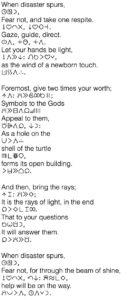
The other is three lines that contain a message for the next part of the escape room:

After deciphering it, the message reads:
“Appeal for help through this: First, bring two symbols to the hole in the wall. Then, bring the light to it.”
The instructions allude to the light sensor near the wall that the players have to line up two disks on and shine a light through the slits, in order for the LED signal light to be lit.
The next part of the game is to decipher a wall of symbols that will provide the correct disks to use in the light sensor. Each disk has a different set of symbols on it. Either a set of triangles or a set of circles. To figure out the correct disk to use, the players have to use pieces of paper (that they also find around the room) that have a grid pattern on them showing which panels to cover on the wall. In order to figure out the order of the papers, there are drawings on the back that align at the edges of the paper. Each panel on the wall has a triangle or a circle, so by covering the correct panels the players can find the two correct disks.
After the players select the two correct disks, they have to put them into the slot of the light sensor and shine a light through the slits. The light sensor will only light up if the proper sensors are covered and exposed. Therefore, there is only one correct orientation with the corresponding disks. Once the light sensor is activated, help is sent to the stranded astronauts and they are able to escape the room.
Future Directions & Development
Given that the final playtest took place in the actual room, we encountered new issues that we hadn’t seen in our individual puzzle playtests.
One of the biggest pieces of feedback we received was with the hint system, since they were set to be released at preset time intervals instead of when players needed the hint. This caused some frustration amongst some players since they were looking for hints and only received ones related to puzzles they had already solved. In the future, we want to include a system of adaptive hints that can be released according to the stage of the room players are on.
Another place for improvement would be the use of our props. Along with all of the objects that were needed for puzzles, we included a few other props in the room that would add to the overall experience and mood of the room (e.g. a globe, a sun shaped clock, a radio, etc.). While this was the intention, we received feedback from our playtesters that the props were a bit of a distraction, since they believed that they had a purpose in the puzzles. Additionally, some of the props chosen had potential to be misunderstood as parts of the puzzle. For example, the sun clock had two hands pointed in different directions, which could be misinterpreted as how our two disks should be oriented. There was also a prop with slits around it that could fit our disks. We realized that since our room wasn’t fully decorated, we should be more careful in the future about introducing red herrings.
In our grid puzzle, we had four sheets of paper that indicated which symbols should be on the disks. We had arrows on the top of each pointing upwards to show the correct orientation of these papers, but the design of the arrows were filled in triangles that looked like the triangles symbols on the disks. While players were able to see that the arrows were for orientation, it initially caused some confusion. Similarly, the players were confused as to how many disks should be placed in our holder, since based on the width of the holder, it seemed like it should’ve fit three disks. We realized how important the small design elements were in creating a more intuitive experience. One place where the design of objects did aid in problem solving was the shape of the light and the disk holder’s shape. Both were circles with about the same diameter, and with a hole in the center. We also placed it close to the disk holder, so players were able to identify its use case without extra hints.
Overall, in the future, we want to be more intentional with some of our design elements and make sure that additional components don’t add an extra layer of confusion for players. We would also like to see how we can make our room more accessible and see how we can come back to our original idea of making the escape room blind accessible. Even with the issues here and there, the players definitely experienced the types of fun we were going for: fellowship, discovery, and challenge.
Visuals
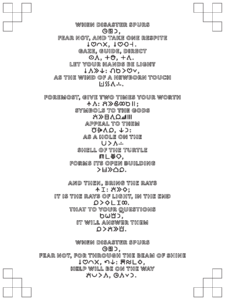
Alien poem design (printed on duron board).
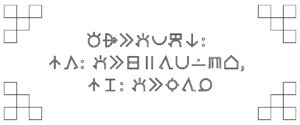
Alien sign design (printed on duron board).
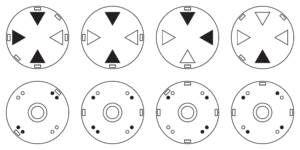
Alien disk design (printed on duron board).
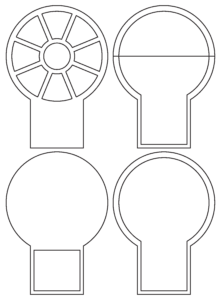
Light sensor frame cross-sections (printed on duron board).
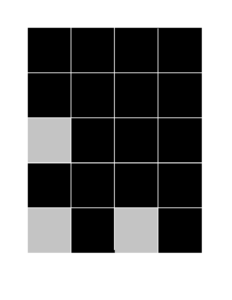
Sample grid puzzle sheet (printed on paper).
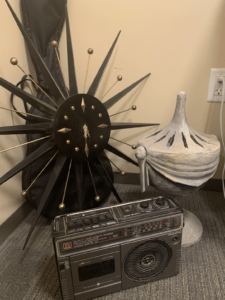
Assorted props.
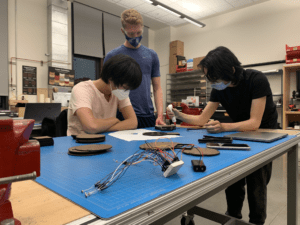
Gluing the light sensor frame.
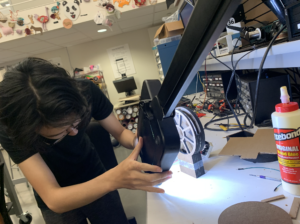
Testing the light sensor.
Final Playtest Feedbacks
Heist at the Cantor! (Peter)
I also took on Heist at the Cantor as part of our team’s final playtest. Heist leveraged space in a very thoughtful manner—rather than taking the approach of “how can we make a simple space compelling?” or trying to make an area simulate another setting, the game made use of already-existing features of campus. Given the range of artistic landmarks in proximity, the choice of Cantor as a home base was a savvy one, and it felt like many of the subsequent design decisions centered around accentuating that core premise.
In addition to the types of fun that Tristan discussed (of which I’d like to also celebrate fellowship fun myself later), I found discovery fun to be another strong suit of Heist. Although I’ve meandered around Cantor — and sure, I’ve seen the Rodin sculptures plenty of times — I’ve never done so with quite an intention and purpose. Of particular fascination to me is how space, even that I was relatively familiar with, could change so dramatically in the context of a game.
One of the strongest aspects of Heist was its collaborative nature, which ties in with the aforementioned fellowship fun. I also loved the simultaneous QR code sequence, and the fact that each puzzle after the first could be made more efficient by splitting up as a team (of which, given the time pressure, it was important to take advantage of) reinforced the format of having multiple players taking on the game.
Thinking from a design perspective, I was impressed how much work went on from the back end to make for a smooth playing experience. In the same way that we needed our full team to conquer the puzzles, the full design team was clearly required to run the game — sending off texts, responding to hints, jumping between locations, and keeping in touch as to where our team’s progress stood at any given time. For Heist, the game is much more than a standalone product — it executes live with deliberate effort.
I, too, wonder if there might be a way to create a little more variety in the puzzles; perhaps leveraging the texting system could allow for a solution that doesn’t require solving a lock. That the players must have their phones available also creates an opportunity to probe the technical end of things more — would it be possible to have another sequence or reaction-based challenge? Overall, though, I found Heist a wonderful time, and was very, very impressed with its thoughtfulness and smooth play in such a unique game.
What’s the Move (Qiantan)
What’s the Move is defined by its creators as “an escape room in the box”, a.k.a. a scaled down version of an escape room that can be played over tabletop. The story is about the character waking up with a hangover, only to find themselves alone and that their roommate left a number of mysterious clues. The goal is then to decipher those clues and join the party with their roommate. The target audience will be small groups of college to high school students. We tested it with 2 players, and I think the game can scale to 4 players. The current game prototype consists of four puzzles, and the players need to solve them in linear progression to unlock a lockbox. The settings are relatable to normal school life and the players need to work cooperatively towards the goal, therefore the game will be a good way to form companionship between the players. The four puzzles I played are: 1) Complete a jigsaw puzzle and a word that describes the completed picture is the first key. 2) Use the lookup table on the backside of the puzzle to decipher an email text to get the second key. 3) Unlock a phone to see the chat history between the character and their roommate, notice that the first letters of each of the roommate’s messages form the third key. 4) Inspect a social media app on another phone, find the common theme of the posts and put it in the search box, use the first letters of the search results to form the fourth key.
The types of fun I notice the most are fellowship and challenge. While none of the puzzles technically require multiple players, good teamwork and discussion helps a lot in the process. The puzzles are all challenging, with just the right level of difficulty. Solving each of the puzzles brings the players a sense of accomplishment.
One thing that differentiates the game is the use of realistic clones of everyday software/apps used by average school students. The second puzzle is presented with an Email program on a laptop, the third with a mock SMS client on a phone and the fourth with a mock social media app on a phone. These mock software/apps make the story more realistic and relatable, and also enables new kinds of interactions and puzzles. For example, in the last puzzle the players have to put the correct keyword in the search box and new clues are revealed in the search results. Overall, I think these are very clever and effective ways of blending technology elements into the game.
One thing that I think can be improved is the hint system of the game. During the playtest, the hints are given out directly by the moderators when the players are stuck. I think a good way to automate this as well as reducing the subjective influence of the moderators is to integrate a hint system into the mock software/apps. For example, if the players haven’t made any progress for a specific amount of time, the SMS client may display a new message containing some hints from the roommate.
Heist at the Cantor! (Emily)
Heist at the Cantor! was a very fun and creative game that employed an excellent use of outdoors space and collaborative problem-solving. The game had a well thought out narrative and personality behind the characters that added to the fun of the game. There were four puzzles that we were tasked with solving. After we solved each one, we would gain another corner of the map, where we would ultimately be led to the painting dealer to receive our reward.
We started out at the front of the Cantor Museum, where we were introduced to our mission by a secret agent. The first challenge was to solve a “wordle”-like puzzle and guess the correct word. An epic success moment was when Tristan clicked the screen randomly and happened to get the right word on the first try. The only point of improvement I would have for the game was to provide a bigger device for this part of the game as it was difficult for everyone to see the screen on a small phone.
The second part of the game was to go to the statue garden and crack a combination lock. I thought this was such a creative use of existing architecture as there happened to be only three statues with dates on them that gave the order of the combination. We also had to use our hint here which directed us to count the heads of the statue to get the actual numbers we were supposed to input into the lock.
A particular “fail” moment was when we took a long time to interpret the map and find the directions to the next stop. In fact, I felt like navigating the physical space was the most difficult part of the game, not the puzzles themselves. Another unique aspect of the game was the use of a shared group chat to provide information at every step of the game. I thought this was a resourceful way of communicating to the players and making sure they had the right information at the right time. It would also be a good place for automation if the game is to be sustainable for many groups in the future.
The type of fun this game successfully created was fellowship, challenge, and fantasy. This game features many opportunities for cooperation, especially in the final puzzle where we had to scan two QR codes at the same time in different locations. I also thought this game had just enough challenge to make us think, but also not too much to the point where it was frustrating to solve the puzzles. Finally, the “heist” narrative of the game created a cohesive theme for the players to immerse themselves in the storyline.
Locked Door Office Hours (Neha)
Formal elements: Locked Door Office Hours is a physical escape room. The game centers around the sudden death of a girl near Lake Lag. She has been reported to be killed by a cult, but there are speculations that her father, who is a professor at Stanford, is the real murderer. The players’ task is to figure out who the true murderer is. To do this, they must solve different puzzles related to mystery and uncover information that helps them understand the true details around the crime. The target audience of the game would be older high schoolers to college students, in groups of 3 – 6. Although the actual puzzles could be solved by a younger audience, the themes of the narrative included mentions of cults and drugs, which is why it would be aimed towards an older audience. The players would not have to be particularly close with one another, and the game would be a great way to foster new friendships and camaraderie while trying to solve the mystery. The two puzzles that I played from the game were 1) to identify the message from a circuit drawing and 2) answer questions about the mystery based on a video of a news reporting on the murder.
Types of fun: The types of fun that I noticed the most were fellowship, challenge, discovery, and narrative.
- Fellowship: Being able to discuss different theories about the murder created a sense of fellowship, since everyone had one goal. There was also a lot of information to keep track of, so having and relying on others to remember different things aided in fellowship.
- Challenge and Discovery: These two go a little hand in hand, because discovery was the main way of gaining information about the murder, but there was a challenge in connecting the dots between different pieces of information to jump to conclusions.
- Narrative: The entire game was to figure out what had happened to a young girl, and the puzzles added information to the overall storyline that was the foundation of the escape room.
Potential improvements: Overall the puzzles I played were really awesome! I especially loved the video they put together of the news report, it made me feel like I was really watching the news.
In terms of the first puzzle, it was a very short puzzle since we were supposed to identify the message in a circuit drawing. The answer was a number (1577) which was fairly easy to tell within the first couple of seconds. There were a lot of tiny pieces of info in the diagram which I thought were relevant, so I would hope that either could add to the overall message. However if the overall room contained a lot of red herrings, I think having the extra information would be justified and add to the idea of solving a real mystery, where you have to see through irrelevant information.
For the second puzzle, it was mostly remembering information and doing a little bit of math to calculate exact dates. I think they did a great job of emphasizing information that would be important. However, I think there could be another element of challenge added that makes the puzzle less linear. They could potentially have put together information from both the video and other parts of the room. Since I didn’t play the full experience, there might have been something similar implemented.
Overall, a really fun game with a great storyline!
Heist at the Cantor! (Tristan)
My team and I participated in the final playtest for Heist at the Cantor, a physical outdoor escape room designed and implemented by Alahji, Ji Hong, Cathay, Jialin, and Kathleen.
Formal elements: Heist was a genuine multiplayer design. Not only does its tasks encourage cooperation between players, certain tasks — like cracking the QR codes within the Sequence exhibit — cannot be completed without deliberate coordination. Procedurally, the game progresses in levels through a map the players slowly piece together. The areas of each level (and task) is cleverly defined by the various art exhibits (Rodin Sculpture Garden, Stone River, Sequence). This design was intentional and well-executed because it allows the players freedom of movement within the exhibits (prompting the exploration of space), but also provides clear limits of the game’s physical boundaries (so that players can focus their efforts and not get lost or confused).
Types of fun: The fact that I was intrigued by the narrative, was always clear about the current objective, and actively participated in solving all the puzzles enthusiastically, speaks to the success of this escape room. In terms of aesthetics of fun, the following stood out the most: fantasy, fellowship, and challenge.
- Fantasy: I really enjoyed the art heist scenario. Doing so created an evocative narrative architecture where I drew from my experiences of watching action movies of the same genre. Meeting bribed security guards and communicating with a shady client through text messages were effective in immersing me in the game.
- Fellowship: As previously mentioned, the level design truly encouraged cooperation. Because the level space was expansive, my team members and I naturally dispersed to gather information and resources, before gathering at a centralized location to piece them together. One of my favorite parts of the game (or moment of particular success, lol) was directing the synchronized scanning of the QR codes in the Sequence sculpture by counting down (3 … 2 … 1!). Participating in tasks that I could not accomplish alone made the game experience more satisfying for me.
- Challenge: I felt reasonably challenged throughout the game, and our team only had to ask for a minor hint once. The moderate difficulty and the game combined with the 30-minute time limit helped propel the game experience.
Potential improvements: Here is my only major point of criticism. As of now, each of the levels (Rodin Sculpture Garden, Stone River, Sequence) has a similar layout. There is a box which, when unlocked, reveals another piece of the map. While I appreciate the use of motifs (because it informs the player and helps track progress), more variety between levels can create unexpected twists and add to the “wow” factor of the game. Perhaps a wrong map piece, security guards unexpectedly showing up, etc.? These twists can also tie in with the heist scenario — things don’t always go as planned.
Ending remarks: I really enjoyed playing through this escape room. It’s clear that it took a lot of effort to design, implement, and coordinate on-site and in real-time. Thus, I am glad to have been able to experience it.


